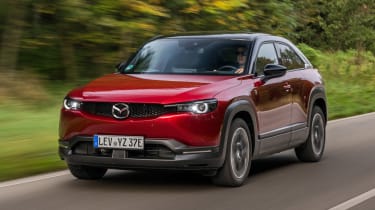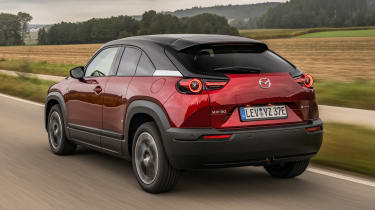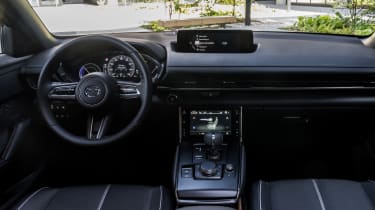The electric MX-30 has always hampered by its limited range, but now Mazda has introduced a rotary plug-in hybrid powertrain
3.5 out of 5
How we review carsBuy used for less at Buyacar
Verdict
Our main gripe with the Mazda MX-30 has been fixed thanks to the additional range afforded by the new rotary plug-in hybrid set up, though it’s still slightly flawed as a family car mainly due to its impractical rear seats. We hope this isn’t a fleeting visit from Mazda’s new rotary and that it finds itself in other applications.
Mazda has produced almost two million rotary engines since the Mazda Cosmo of 1967 – it’s a huge part of the Japanese firm’s identity. Ten years have passed since the last rotary-engine Mazda was made however, with the RX-8 dying out in 2012. The new MX-30 R-EV marks a return of the iconic powertrain, but is this latest arrival cause for celebration among fans of the Wankel engine?
The short answer is, no. If you’re looking for a car that screams to the redline and gulps down fuel like the old RX-8 and RX-7 did, then the MX-30 R-EV is not for you. In fact, it's designed to be the very antithesis of this. Anyone that has looked under the bonnet of the regular MX-30 EV would have foreseen the arrival of a hybrid model, such is the gaping space left unused by the compact BEV system. Choosing a rotary to fulfil the needs of an efficient hybrid and boost the usability of the MX-30 is an interesting proposition and certainly a unique offering in 2023.
More reviews
Car group tests
- Mazda MX-30 vs Kia Soul EV
- Mazda MX-30 review
- Mazda MX-30 GT Sport Tech: long-term test review
- New Mazda MX-30 2021 review
In-depth reviews
Long-term tests
Road tests
A range-extender plug-in hybrid, the MX-30 R-EV first and foremost comfortably deals with the main stumbling block of the pure-electric MX-30, which is its lacklustre range. With the relatively compact 35.5kWh battery, we recently only managed to extract a maximum of 108 miles from the EV. The R-EV comes with a battery half the size at 17.8kWh but will offer 53 miles of pure-electric driving – not bad for a PHEV. The full range is over 400 miles for the R-EV.
There’s virtually nothing to separate the two models in terms of pricing. Like the EV there are three trim levels for the rotary plug-in hybrid – Prime-Line at £31,250, Exclusive-Line at £33,150 and the range-topping Makoto at £36,000 – £450 more than the fully-electric equivalent.
The best part of the MX-30 EV is the interior and overall build quality, and this is unsurprisingly carried over to the R-EV – along with the rather wacky use of cork trim in the cabin and the rear-hinged rear doors that pay tribute to the RX-8. The MX-30 feels mature inside though, the physical switches on the steering wheel are assuring to use, as is the dial for the dash-mounted 8.8-inch touchscreen. We just wish the same functional approach would’ve been used for the climate controls – which aren’t the easiest to operate on a seven-inch screen positioned low-down on the centre console.
All MX-30s are well-equipped with adaptive cruise control, a head-up display, blind spot monitoring, lane keep assist, LED lights, Apple CarPlay and Android Auto connectivity, and powered wing mirrors all standard. The Makoto version we’re driving features a 360-degree camera, adaptive LED headlights, 18-inch wheels that are bespoke to the R-EV, a powered sunroof and a three-pin 1500W socket to power appliances.
The rotor itself is different to the Renesis twin-rotor of the old RX-8. A single rotor, it’s thinner but has a larger radius and comes with a new compression ratio that focuses on delivering efficiency rather than power. The rotary engine is famed for its high-revving capacity but for the purposes of generating power for an electric motor, Mazda has kept the optimum output of 75bhp relatively low at around 4,500rpm. Owners of RX-7s and RX-8s may be interested to hear that reliability should be better with this new rotor, with thicker apex seals and less oil use.
One of the reasons Mazda decided to bring back the rotary for the MX-30 R-EV rather than slot in an in-line piston engine was due to weight and packaging. The compact rotary unit is 15kg less than the RX-8’s rotor thanks to use of aluminium and should mean the R-EV handles like the EV, according to Mazda.
On twisty roads it’s almost imperceptible to tell the difference from the EV, with a decent amount of front-end grip, reassuring steering feel and not too much body roll. The plug-in hybrid system does add 131kg to the kerbweight and it’s marginally less compliant over larger potholes, but for the most part it rides just as well as any of its rivals.
Considering prices for the rotary MX-30 mimic that of the EV, it does feel like Mazda has admitted defeat with the all-electric model – and some rather poor sales figures would appear to back this notion up. The MX-30 R-EV is certainly easier to recommend not just because of its far more useful range but also because it seems like a more well-rounded proposition.
Mazda claims fuel efficiency of 282.5mpg, and like most plug-in hybrids you’ll struggle to reach that eye-catching figure unless you’re in EV mode for the majority of the time, but we were impressed with the additional range of the battery. We ran the battery percentage down to zero and the MX-30 soldiered on in EV mode for a few miles after without a hint of engaging the rotary generator.
Perhaps the most exciting point to be made with the MX-30 R-EV is what it could precede. We know Mazda has been keen to re-introduce the rotary into its line up, but confining this technology to a mere range-extending generator seems a little depressing – even if the actual utilisation in the MX-30 R-EV is admirable.
| Model: | Mazda MX-30 R-EV Makoto |
| Price: | £36,000 |
| Powertrain: | 0.8-litre, single-rotor + electric motor |
| Transmission: | Single speed gearbox |
| Power/torque: | 170bhp/260Nm |
| 0-62mph: | 9.1 seconds |
| Top speed: | 87mph |
| Economy/efficiency: | 282.5mpg/21g/km |
| On sale: | Now |
Source: Read Full Article




